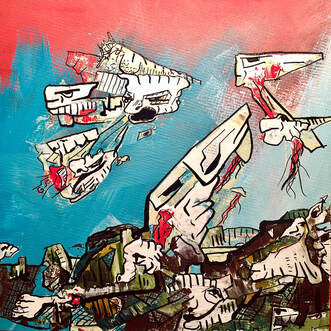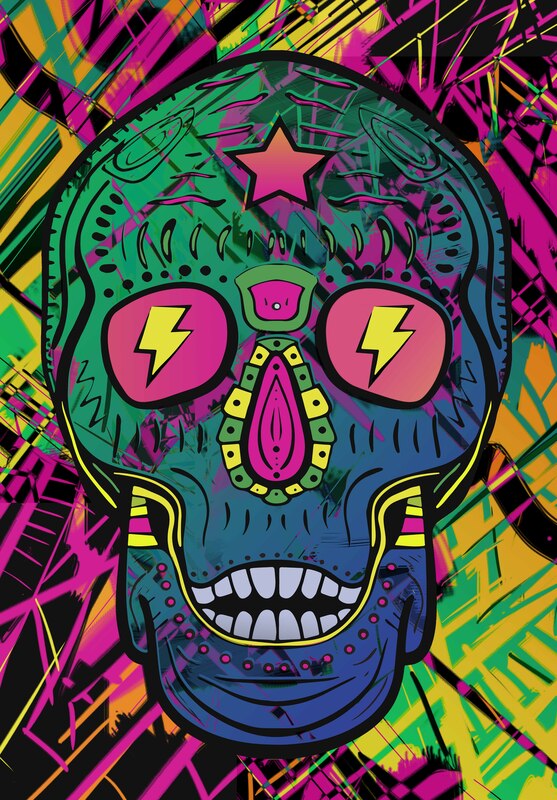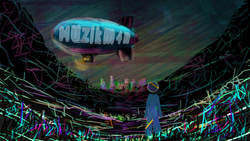|
Dogecoin Investing Oracle NFTS
NFTs are a fairly new concept within the online art community. It can be an overwhelming concept if you aren't even familiar with crypto currencies. NFT stands for "Non Fungible Tokens" and is essentially digital versions of either graphic art or pictures of physical art. It can even be a meme, gif, video, a website url, and the list keeps growing. As an artist, you can potentially list an image of a painting or digital image you created and it would sell to the highest bidder in the form of crypto currencies. You can then hold onto that crypto payment and see if it continues to grow, or cash it out for a USD currency. Why do people buy digital art you may ask? Think of it as cutting out the middle man, the art world. Art has become a symbol of wealth and power, where the rich collect paintings such as Jackson Pollocks and it increases in value and shows off how much wealth they have. Now apply this concept to NFTs for a new generation of crypto wealth. This concept allows you to purchase digital art within a digital portfolio. The digital art can then be traded amongst other NFT collectors. You can explore NFTs to invest in here.
0 Comments
Do you ever see faces or animals in the clouds? This concept is called "Pareidolia" and was used by great artists like Salvado Dali and Leonardo da Vinci. Together we will push ourselves to see unique characters in random shapes of your abstract marks and learn how you can apply this technique to your own paintings.
This class will focus on reacting to pre-painted abstract paintings with pen and paint and finding faces or animals within the paint. Class Cost: $30 https://shop.imurj.com/collections/workshops/products/abstract-painting-workshop Supplies for Class can be purchased for $10 cash to the instructor extra upon arriving. Blue Town, Green Town, a children's book about conflict, compassion and compromise. What happens when a stranger brings new ideas to a peaceful town and people begin to disagree? Follow along Melvin's journey, a small boy on a mission to bring peace and understanding to a town divided in two. Perfect for readers of all ages. Blue Town, Green Town helps everyone find their voice as a peacemaker and a reminder of how unresolved conflict affects us all.
All illustrations where created with paint and ink on water color paper. Order your copy on Amazon here, paperback or kindle available.  My work exhibits the psychological phenomenon of pareidolia- a type of illusion or misperception involving a vague or obscure stimulus being perceived as something clear and distinct. The most common thing for people to see is faces and animals. My interest in pareidolia began when a woman bought a painting from me of a cloud scene claiming to see the child she lost at birth within the cloudscape. Since then I have always been interested in the reasons we see seemingly significant illusions. In early 2000 a woman named Diana Duyser claimed to see the Virgin Mary on a piece of toast. She auctioned the item off for 28,000 dollars. In 2006 a satellite image of a face in the Cydonia region of Mars was discovered, which led to conspiracy theories that the United States was trying to hide the existence of intelligent life on Mars. I am interested in the reasons we appear to see faces in inanimate objects. There has been scientific evidence supporting the theory that as humans, our brains are programed to instinctively recognize faces primarily. The oldest artifact ever found is the Waterworn pebble, from Makapansgat South Africa, dating back to 3,000,000 BC, which resembled a human face. It suggests that a humanoid found this unaltered pebble and found it significant enough to pick up because of its close resemblance to a face. “While the human tendency to see faces in other objects is rooted in neural architecture, the large number of actual faces we see every day may also be partly responsible for the Nun Bun phenomenon,'' said Takeo Watanabe, a neuroscientist at Boston University. His studies show that after the brain is bombarded with a stimulus, it continues to perceive that stimulus even when it is not present” (Svoboda). My perception often begins from the concept of pareidolia. My art starts off by creating a mark, and then finding meaning within the matrix. Each of us has a very unique and random set of stimulus determined by the people we meet, the choices we make, our beliefs, memories, etc. I intend to use Pareidolia to make sense of my own seemingly random stimuli. “Our brain is wired to find meaning. Our aptitude to identify structure and order around us, combined with our superior talent for face detection, can lead to spectacular cases of pareidolia, with significant effects in society and in culture” (MARTINEZ-CONDE). Along with making sense of my personal stimuli, I intend to see if I can control the images my mind projects onto a surface by overloading the brain with a stimulus to see if the brain really does “continue to perceive that stimulus even when it is not present”. In 2005 the term Abstract Extractionism was invented as a term to group Pareidolia artists. Abstract Extractionism is defined as the study and practice of the recognition of an idea, image, scene, or other abstract in Abstraction and the subsequent extraction of it, utilizing the Cavazu method, in part or in whole (Abstract Extractionism). My work is meant as a guide for me to understand the recognition of idea from random stimuli within abstraction. My current body of work uses strict guidelines of creating a mark, and then reacting to the mark, or the space around the mark. My work utilizes the Cavazu method (trademark of Ismael Cavazos) which is a five step process: First most being abstraction :Begin with an object that will be used for inspiration (Matrix). This can be anything abstract or abstracted. Second is recognition: the artist’s recognition can vary from replica to abstraction. Third is preservation: Depending on the amount of extraction that will take place, the artist should preserve the matrix before extracting the recognition; keeping in mind the presentation. Next is Extraction: From sculpting away, to merely pointing it out, the artist coaxes the suggestion from the Matrix. Lastly is presentation: Exhibition of the Abstract (Matrix) and Extract varies greatly and can be anything from a simple side-by-side presentation to elaborate viewer interactivity that reveals the Extraction (Abstract Extractionism). Many believe that all artists have a heightened sense of pareidolia. For centuries artists have been using this technique for creating artwork. Although the term “Pareidolia” has only been around since 1994, there have been many terms coined over the years that sought to define pareidolia. Many of the definitions can bias either towards “chance/random or destiny/divinely ordained” (Abstract Extractionism). In 1754, the term serendipity was invented by Horace Walpole, meaning a “happy accident”. Throughout history the terms evolved to better describe this phenomenon- 1785, Cozen’s New Method; 1875-1961, Car Jung’s Synchronicity; 1930’s, Dali’s Parnoiac-Critical Method; and in 1958, Klaus Conrad’s Apopheni. All of the definitions mean basically the same thing, each with their own bias, whether it be bias towards a state of mind, or bias to the self. Leonardo Da Vinci was a strong believer of pareidolia, as he states in his journal: “If you look at any walls spotted with various stains or with a mixture of different kinds of stones, if you are about to invent some scene you will be able to see in it a resemblance to various different landscapes adorned with mountains, rivers, rocks, trees, plains, wide valleys, and various groups of hills. You will also be able to see divers combats and figures in quick movement, and strange expressions of faces, and outlandish costumes, and an infinite number of things which you can then reduce into separate and well conceived forms” (John R.). In the contemporary art world artists that take part in this process are now considered Extractionists (term dated in 2000) or Abstract Extractionists (2005). Salvador Dali believed the paranoiac-critical method to play a key role in the creation of surrealism. Dali saw this process as an extension of the self and aimed for “systematic confusion”, which sought to create a new order, taking unrelated elements from the external reality to create a space that is uniquely his own. Dali states that “The moment is at hand when, by a process of a paranoiac and active character, it is possible to systematize confusion and thus help to discredit completely the world of reality” (Finkelstein 60). He believes this is the absolute best way to hone his skills of illuminated delusion, as he so boldly states in the first issue of Le Surrealisme au Service de la Revolution that the concept of paranoiac-critical is “the most precise and comprehensive statement of purpose with regards to paranoiac process” (Finkelstein 60) Max Ernst did not believe this was the best method of extraction. He instead believed the best method of practical application lay within frottage- a technique developed by Ernst in which the artist creates a rubbing over a textured surface. It can be left as is, or is used as a basis for further refinement (Finkelstein 59). There are many contemporary artists exploring pareidolia, one being Ismael Cavazos, the inventor of the term “abstract extractionism” in 2005. He resides within Austin and Houston, Texas. Cavazos is primarily interested in scriblism, and using automatism as means of extraction. The other half of his work is sculpting away parts of a peanut, finding images like a bat, faces, and potted plants. In the year 2000, Rob Nye, invented the term “extractionism” as a term to describe how his work reflects pareidolia. He received his BFA from the university of Southern California, and studied at L.A Art center. He worked as a film producer, a senior advertising executive, and a creative director for thirty years before becoming a professional artist to explore Extractionism with his painting. He has displayed his work in national and regional competitions, and had solo exhibits in San Francisco and California. He believes his dyslexia enhances the images his mind projects onto surfaces. “His work is very abstract and bright, Nye creates his work by extracting human and natural forms he sees embedded in tiny bits of weathered stone and metal. His perceptions are then translated into large scale paintings using a unique, self-developed process combining oil paint, ink dye, oil-based pastels, and high gloss acrylics to produce images”(Studio 47). A gallery that seems fond of displaying Extractionst work is Studio 47, in Vermont, houses work from local, national, and international artists. It is a colossal historic sight, encasing three galleries within the walls. Another exceptional artist using pareidolia for her work is Maya Erdelyi. Erdelyi received her BA in studio art with a minor in film from Hunter College. She went to Harvard Graduate School of Education, and CalArts. She has a long list of awards and recognitions throughout the nation, mainly for her film and animation. Her work is very bright, painterly and quirky. Collaged materials seems to be a favorite and she often incorporates text within her work. Award winning artist, Vesna Jovanovic, born in Chicago, Illinois,1976, works with combining her interests in science and perceptual phenomena. She usually works within well-established visual languages such as scientific illustration, often including chance occurrences in her process. Her work often represents the duality between order and chaos. Jovanovic currently resides in Chicago, Illinois. As you can see, pareidolia, or Abstract Extractionism plays a huge part in many artists' lives and will continue to do so until the test of time. The term may continue to change over the centuries, but it will always be a way for one to find truth within themselves and create new order. Works Cited Martinez-Conde, Susana, and Stephen L. Macknik.”A Faithful Resemblance." Scientific American Mind (2012): 19-21. Academic Search Complete. Web. 6 Nov. 2012. "Abstract Extractionism ." www.pareidolia.us. N.p.. Web. 6 Nov 2012. <http://www.abstractextractionism.com/>. Svoboda, Elizabeth. "Faces, Faces Everywhere." New York Times. 13 2007: n. page. Web. 6 Nov. 2012.<http://www.nytimes.com/2007/02/13/health/psychology/13face.html?pagewanted=1&_r=0>. John R; J. Don Read (1923). "Leonardo Da Vinci S Note-Books Arranged And Rendered Into English". Empire State Book Company.. Finkelstein, Haim. "Dali's Paranoia-Criticism Or The Exercise Of Freedom." Twentieth Century Literature 21.1 (1975): 59.Academic Search Complete. Web. 6 Nov. 2012. Studio 47.< www.artpolonaise.com>. |
Leitner Studios Blog
Author: Justin Leitner
Fine Artist/ Freelance Graphic Designer/ Instructor Archives
November 2019
Categories
All
|









